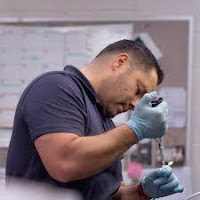USU’s Neuroscience Program Develops Exemplary Leaders, Scientists
By Dillon Parker
Techniques across the entire range of scientific disciplines from molecular biology to experimental psychology are required to investigate the most complex structure in the body: the nervous system. The Uniformed Services University’s (USU) Graduate Program in Neuroscience (NES) focuses on leveraging these techniques to make a difference in medicine while also addressing some of the pre-eminent medical issues facing the military community.
“We have expertise in traumatic brain injury (TBI), post-traumatic stress disorder (PTSD), central nervous system development, memory, and several other areas as well,” said USU’s Dr. Kimberly Byrnes, the NES program director. “A lot of our research has a military relevance and supports the university’s mission of caring for the warfighter.”
In order to take these research conclusions on critical disorders and translate them into changes in clinical practice, NES program graduates must be experts in their research areas. They also need to be experts in more practical aspects such as analytical skills, communication, and leadership. One important way the NES program develops graduates with these capabilities is by utilizing an interdisciplinary approach, as well as faculty with clinical ties.
The NES program also offers an array of outside resources that enable students to develop close relationships with leaders from important institutions in the military and medical communities. The program neighbors the National Institutes of Health and has strong ties to other federal agencies, and within the Department of Defense. Students can also take courses at nearby universities such as the University of Maryland and Georgetown University, through USU’s membership in the Consortium of Universities of the Washington Metropolitan Area.
These resources support students like Haley Spencer, a third-year doctoral student whose research focus, a potential treatment for TBI, exemplifies the type of applied research students in the NES program focus on.
“I’m studying how the drug ketamine affects inflammation, and I’m particularly interested to see how it could affect inflammation after TBI,” said Spencer. “For a long time it was thought you couldn’t use ketamine with TBI because of an increase in intracranial pressure, but newer research is showing that it doesn’t do that. There’s also a lot of [information] out there about its anti-inflammatory properties, which is what I’m interested in because it could be beneficial for TBI.”
Spencer chose the NES program because of its focus on TBI. She enjoys other aspects of the program, too, such as interactions with faculty and students and the opportunities to develop communication skills needed in her career after graduation.
“You get a lot of opportunities to practice talking about your science and communicating with students and faculty,” said Spencer. “There’s a collaborative aspect here that I really enjoy that helps you develop communication skills. It’s not a super competitive environment where students are battling against each other, everyone is really helpful and wants you to succeed. The skills I’m learning here are going to help me no matter which career I go into.”
Another unique aspect that students enjoy is the opportunity to learn about more concrete aspects of neuroscience due to the faculties’ medical expertise, and course offerings such as neuroanatomy.
“A highlight of our program that is really different from neuroscience programs elsewhere in the country is that we take neuroanatomy, which is taught by some of the clinicians that teach the medical students,” said Spencer. “We actually get to do anatomy dissection on the nervous system, and it’s such a big difference to see it on a person rather than in pictures or on animals. It’s a really cool experience and I know everyone in my program has enjoyed getting to do it.”
All of these factors make USU’s NES program a perfect match for applicants interested in becoming leaders in neuroscience, and whose research interests relate closely to the faculty’s areas of expertise, such as pain and trauma.
“Overall, we’re similar to other neuroscience programs, but we have so many things here that set us apart and make the program particularly strong and interesting,” said Byrnes. “We’re looking for students with a pretty broad background in sciences, who know what their research interests are. While they’re here we expect them to develop into leaders and good citizens of the neuroscience community, that’s our goal.”
For more information on the NES program, visit the USU website.







